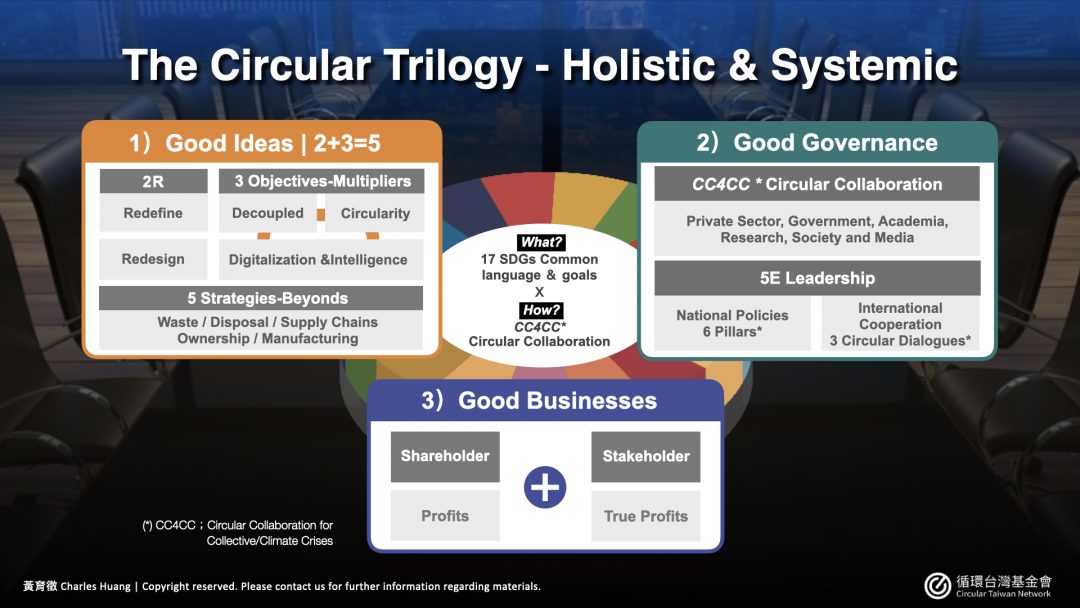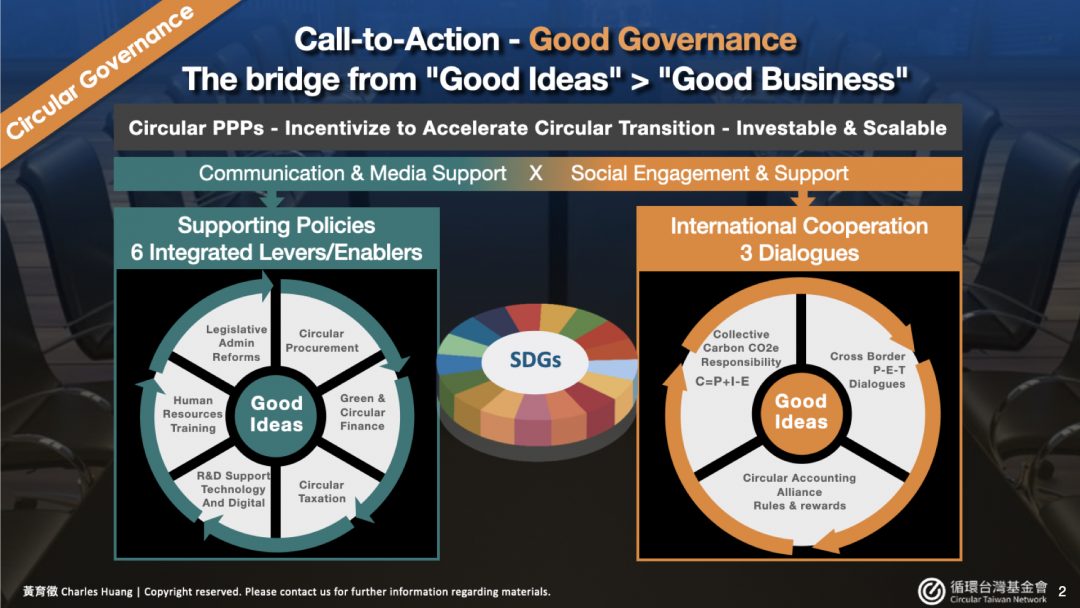The United Nations’ 17 Sustainable Development Goals (SDGs) provide a shared global direction for humanity. The circular economy is a key pathway to achieving these goals, and the Circular Trilogy serves as a practical guide to realizing the circular transition.
It bridges the gap between good ideas and good business, where good governance becomes the vital connector that transforms innovation into impact.
The Circular Trilogy is not only a guide for corporate transformation but also a policy blueprint for building a resilient, net-zero, and progressive nation.

Creating “circular good ideas” requires two core mindsets and the implementation of three key goals and five strategic actions.
The goal is to decouple resource use from economic growth, ensuring that well-being no longer depends on extraction and replacement. At the same time, resources must circulate continuously to retain and regenerate value.
Two Core Mindsets
- Redefine: Rethink needs and consumption patterns.
- Redesign: Reshape business models for circularity.
Three Goals
- Decoupled: Separate economic growth from resource depletion.
- Circularity: Achieve a high rate of resource reuse and regeneration.
- Digitalization/Intelligence: Use digital technologies to drive circular innovation.
Five Strategic Actions
- Beyond Ownership: Shift from “owning” to “using.”
Redefine user needs through subscription, rental, and sharing models that meet lifestyle demands efficiently while reducing waste.
- Beyond Manufacturing: Replace “selling” with “serving.”
Manufacturers can transform into service providers, focusing on maintenance, upgrades, and performance optimization. This approach extends product lifespans while creating long-term revenue and customer relationships.
- Beyond Supply Chains: Build service-based networks.
Companies no longer just deliver goods, they provide integrated services combining products, support, and data systems. Digital platforms can connect logistics, repair, recycling, and carbon management, transforming linear supply chains into circular service ecosystems.
- Beyond Waste: View waste as misplaced resources.
When materials have traceable identities, they can circulate in secondary markets. Industrial symbiosis — where by-products become inputs for other sectors — turns waste into renewable materials or energy sources.
- Beyond Disposal: Treat surplus resources as assets, not liabilities.
Unavoidable residual resources can still have value. Governments and companies can use procurement mechanisms to transform what once incurred disposal costs into revenue-generating resources.
Throughout this process, digitalization and intelligent systems play a crucial role, enabling product tracking, system integration, and resource matching to operationalize new circular business models.
Circular good governance builds systemic collaboration across public, private, academic, and civil sectors — locally and globally — through six policy levers and three global dialogues.

Six Policy Levers
- Legislative Admin Reforms: Modernize outdated regulatory logic. Replace control-based laws with incentive-based frameworks (e.g., replacing the Waste Management Act with the Circular Economy Promotion Act).
- Circular Procurement: Leverage government purchasing power to accelerate market transformation, channeling national budgets to support circular innovation.
- Green & Circular Finance: Establish circular transition funds (e.g., Green Growth Fund) as financial backbones for innovation.
- Circular Taxation: Introduce tax incentives that make circular investment an asset, not a cost, requiring inter-ministerial collaboration between finance and regulatory bodies.
- Human Resources Training: Cultivate a new generation of talent equipped with circular thinking and cross-disciplinary capabilities for knowledge- and service-based economies.
- R&D support Technology & Digitalization: Build smart data systems for resource tracking, recycling, and remanufacturing, making circular flows visible, measurable, and traceable.
Three Global Dialogues
1. Trade and Economic Negotiations
Traditional trade talks have long encouraged “produce more, sell more,” leading to higher emissions. Future trade frameworks must embed circular economy principles into global political, economic, and industrial dialogues, aligning producers and consumers toward shared decarbonization along value chains.
(Further Reading: EU–Taiwan collaboration on circular economy)
2. Consumption-Based Carbon Accounting
Most countries still calculate emissions using a production-based approach. This creates tension, as consumption countries blame production countries for carbon footprints.
A consumption-based approach — using the PIE (Production + Import – Export) model — promotes shared responsibility and collaboration, enabling nations to co-develop carbon reduction solutions rather than shift blame.
(Further Reading: Carbon Fees as a Catalyst for Corporate and Societal Transformation)
3. Circular Accounting Alliance
Traditional accounting undervalues circular innovation. Depreciation-based methods ignore the appreciating potential of materials in a regenerative system. Reforming accounting standards is therefore essential.
A global Circular Accounting Alliance can establish financial principles that reflect circular value creation, ensuring innovations are properly represented on balance sheets.
(Further Reading: Circular Taxation, Accounting, and Finance: The Real Engines of Corporate Net-Zero Transformation)
In the circular economy, corporate success is no longer defined solely by shareholder profit, but by True Profit, which reflects value creation for all stakeholders.
By internalizing positive externalities such as environmental restoration, health, and inclusion, businesses can create 6E Benefits that extend beyond economic returns.
The 6E Benefits
- Economy: Enhance resource efficiency, reduce costs, and develop new models such as product-as-a-service, sharing platforms, and remanufacturing.
- Employment: Generate new jobs, skills, and local opportunities through cross-sectoral collaboration.
- Energy: Promote renewable and efficient energy use, such as waste heat recovery, renewable integration, and smart energy management.
- Ecology: Embed ecological protection in design and supply chains to reduce pollution and protect biodiversity.
- Environment: Achieve waste reduction and resource recovery, minimizing external environmental costs and improving sustainability performance.
- Education: Integrate circular thinking into corporate learning, empowering employees, partners, and consumers to foster a long-term culture of sustainability.
(Further Reading: How the Bioenergy Industry Generates 6E Benefits)